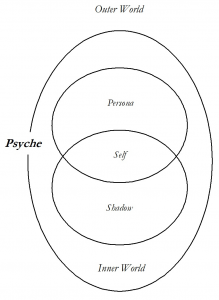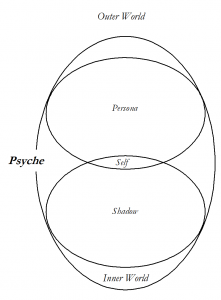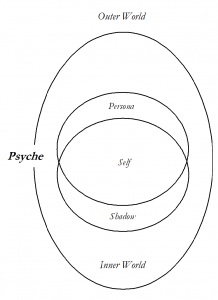This reflection kicks off a three-part exploration of the unknown in our inner worlds, sometimes called the shadow. Part 1 takes up the question “What Is Shadow?” while parts 2 and 3 follow the questions “What Do We Do with Shadow?” and “What Is the Gift of Shadow?”
The Unknown
What Is Shadow? (Part 1 of 3)
For me, some of the most compelling teaching moments in the Gospels begin with Jesus’ words, “You have heard it said . . .” I hear Jesus begin with what is familiar to those to whom he speaks, then continue on, escorting his listeners past what they already know, “but I say unto you . . .” With this formula, he invites people to consider something deeper than the letter of the Law. He reveals a little bit of the unknown. On much more modest scale, I hope to employ Jesus’ formula to share a model for understanding one of the enduring mysteries of the human psyche—the “shadow.” You may have heard it said that the shadow consists of heavy and unwanted inner material that should be avoided. But I say unto you, the shadow holds more than just unwanted material. The shadows are also the unknown within which hidden gifts are waiting to be discovered.
I invite you to consider the possibility that in addition to unwanted material, the shadow might hold wisdom and strengths of which we are not yet aware. What if the Spirit is stirring with an invitation to explore a truth you do not already know? A more well-rounded way of understanding the shadow, then, might include all that is unknown, unfamiliar, and politely tucked away. And a more wholistic view of spiritual practice might include paying closer attention to the shadow.
As I have tried to broaden my thinking about and appreciation shadow, I have been learning a great deal from Robert Johnson, author of Owning Your Own Shadow. Johnson has helped me with language for three parts of my inner world—persona, self, and shadow. He writes, “The persona is what we would like to be and how we wish to be seen by the world . . . . The [self] is what we are and what we know about consciously. The shadow is that part of us we fail to see or know” (3-4, italics added).

Figure 1: Persona, Self, and Shadow
Persona, Self, and Shadow
A diagram locating the shadow within our psyche might look something like Figure 1 at right. As our true self faces the outer world, we look through the lens of a persona, our “psychological clothing” as Johnson put it. We adopt roles and personalities and we approach those roles with preferences for how people see us. What we know about ourselves and choose to share with others becomes filtered through the persona and worn like clothing. What we know about ourselves and choose to keep hidden, however, remains part of the self alone. The anxieties, fears, and dreams of which we are already aware might fall into this category.
Then, when we turn toward the inner world, we look through the lens of the shadow. What we already know has become part of the self. But the shadow holds more for us that we do not yet see. The shadow represents the way into unknown mysteries of our inner worlds. With good effects and ill, these are the unfamiliar parts of us that stir and influence our selves unconsciously.

Figure 2: Thick Persona, Massive Shadow
What I appreciate about this perspective is that it departs somewhat from the conventional assumptions about shadow being the storehouse for evil, dysfunction, or others things we must keep at bay. While such elements might dwell within us, shadow also represents, quite simply, all that which remains within and unknown. That suggests a lifetime of discovery awaiting!
Thick Persona, Massive Shadow
We walk the boundaries of our self and persona and our self and our shadow with some difficulty. Sometimes we are living too much for show and without enough attention to our inner worlds. William Miller, who wrote Your Golden Shadow, describes this as living with a thick persona and a massive shadow. For Miller, "A thick persona means inauthenticity and artificiality. A massive shadow means being severely out of touch with oneself and vulnerable to the powers of one's negative unconscious" (13).

Figure 3: Thin Persona and Moderate Shadow
Imagine the density of the persona and the shadow in relationship. A person who forces forward into the outer world a deep and thick persona has correspondingly massive shadow. People who strike us as inauthentic often seem too forward about how they want to be seen and too inattentive to how their own inner world affects their interactions with others. As we see in the Figure 2, the self is diminished by a thick persona and massive shadow.
Quite the opposite of encountering a thick persona, we appreciate the authenticity of those who practice becoming more aware of what is happening in their inner worlds and what is spilling out into the outer world. I am grateful when a friend apologies and says, “I said that because I was uncomfortable,” just like my friend appreciates it when I can say, “I think I was using my humor to mask my hurt.” Noticing and naming the discomfort and the hurt within us thins the persona through honesty and integrity, shrinks the shadow of one more thing that was hidden, and expands the true and healthy self.
Consider another example from the Gospel of Mark (10:35-52). Jesus poses the same question to James and John and then to Blind Bartimaeus: “What do you want me to do for you?” James and John ask for power, for the privilege of sitting at Jesus’ side in glory. Bartimaeus, however, asks for mercy and healing, for the gift of seeing again. The latter provides us with a better image of a thinner persona and less massive shadow.
Self-Compassion and Vulnerability
As I have filled my journal and interacted with partners who help me pay attention to my own shadow, I am often reminded that I cannot escape the experience of vulnerability and the need for self-compassion any more than the next person. Turning toward the shadow is an act of vulnerability and curiosity at the edge of the unknown. We are wise to go gently with ourselves.
Miller and Johnson say that much of the shadow is developed over time as a response to cues we receive in our various relationships and environments. As we grew and experimented with sharing parts of ourselves with others, we paid close attention—even at an unconscious level—to what won and lost approval. Over time, we learned to tuck away most of what does not conform to the expectations of others. When it comes to appropriate behaviors and necessary contributions to relationships, this process may have been a good thing, overall. But what about the whispers of wanting to be an artist or an astronaut? How many dreams did we tuck back away because someone told us we were being impractical? Miller and Johnson would suggest that our inner worlds took shape as best they could and thickened a persona that could face the outer world and made more massive a shadow that held what we could not yet endure. They encourage us to go gently as we welcome back what has been stored in shadow.
Invitations of Opposites
In addition to the relationship between persona, self, and shadow, I am finding another idea to be especially important—the invitation found in opposites. Miller and Johnson write about a kind of equilibrium between the light that we project to the world and the dark within us. They suggest a law of opposites that recognizes every act of creation requires some destruction and with every yes comes some no to other things. This line of thinking supports how we might accept a “thinning” a persona alongside making the shadow “less massive,” and that corresponds with progress toward a larger self (Figure 3). I am not yet certain that I agree with the 1:1 formula, except for this—I hear a bold call to vigilance about the ways we press our personas into the world, and about the forces of the unknown working within us. We are called to practice more curiosity about our inner worlds.
Whether the concept of shadow is new to you or long familiar, I invite you to acknowledge that there is more to you than is on display, and that there are movements at work in you beyond your ordinary awareness. I trust that the Spirit is working in you to stir a holy discomfort and to beckon toward deeper truth and more authentic relationships.
Diagram Exercise: Print out Figure 1 or draw your own diagram of the psyche. What can you already see about the thickness of your persona and the massiveness of your shadow? What else might be trying to make itself known?
Poem Exercise:This poem was written in honor of my Uncle Paul and is included in Ice Break: A Collection of Poems on Slow Change. Linger with the poem a bit and then explore these questions: Who do you know who “lives their life out loud”? What do you admire about that?
Breadth of Heaven
Some men inspire us,
not by ordinary valor or charm,
but by unpolished authenticity.Absent are the trappings
of bourgeois personas
and the predictability of etiquette.These men laugh deeply, live loudly,
not to meet anyone’s expectations
but to live with pure primal force.For us to avert our eyes from them
is merely to deny our own
shadows politely tucked away.Like Psalmists and jesters of old,
these men dare to do otherwise,
belting their curses and praises out loud.They live through their choices,
bearing repeated witness
to the profusion of God’s grace.Give thanks for men like these
who show the breadth of heaven.

Explore the possibility of spiritual direction with Sam or another member of the Benedictine Center team.







0 Responses